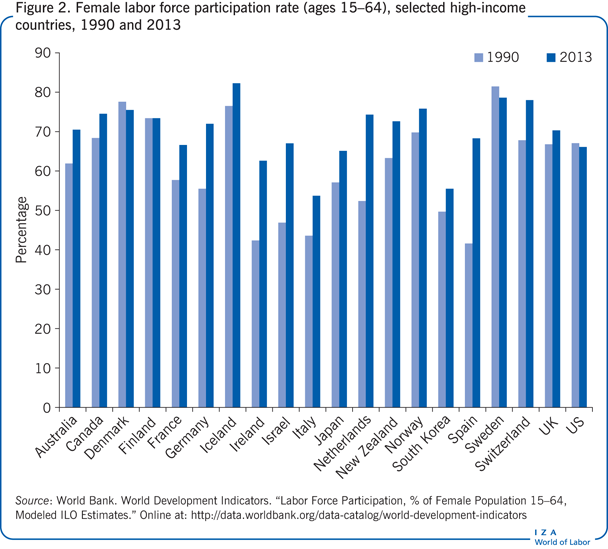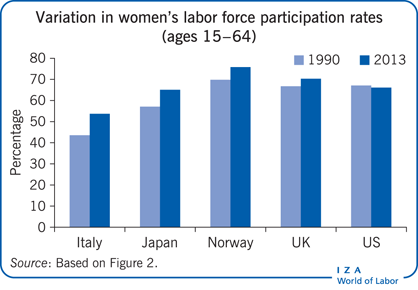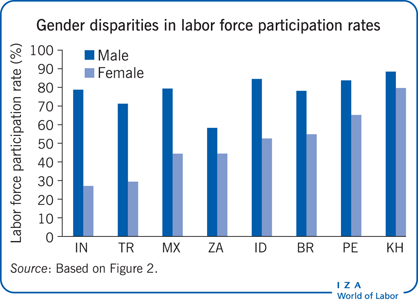Among the factors that influence the participation rate are. The labour force participation rate for male stable in 80 that higher than women which is only condition rate of 50.

Iza World Of Labor Women S Labor Force Participation
Female labour force participation rate in Sri Lanka has remained at a low rate between 3035 per cent in the past two decades which is surprising given the consistently high educational attainment levels and other social indicators of women in the country.

Factors that influence the trend of malaysia female labour force participation rate. Due to ma le. To answer this research question this study aims to identify the influencing determinants that motivate women to participate in the labour market in Malaysia. The labour force participation LFP rate referring to the proportion of the 15-64 population who are in the labour force has increased on the whole driven by rising womens participation.
High wages will encourage more people to seek work and will persuade some to stay in the labour force past the usual retirement age. The female labor force participation rate is historically lower than the male participation rate in Malaysia. Social attitudes to working women.
Labor Force Participation Rate in Malaysia averaged 6704 percent from 2010 until 2021 reaching an all time high of 69 percent in January of 2020 and a record low of 6230 percent in November of 2010. People with disabilities generally. Participation and employment rates are influenced by a number of factors such as economic.
The rapid economic growth was due largely to important growth in the manufacturing and services sectors where substantial and proportionally larger increase of female workers has been registered. Female labour force participation rates vary by individual characteristics including education age and number of children. However the rate showed a modest change from 40 to 49 from 1982 to 2012.
Terms in the major socioeconomic aspects of the countrys development. Between 1970 and 1980 the female labor force participation rate increased significantly from 372 to 445. But it is obviously contradictory to promote female agency while suggesting women should have fewer children.
Based on data that have been collected from primary and secondary sources logit model is used to analyse the factors affecting female labour force participation. The female labour force participation rate is observed to be 228 which is about 42 percentage points more than that of 2018-19. 66 of male wage and in 201 0.
Factors Influencing Female Labor Force Participation in South Africa in 2008 have shown consistency with this trend Ntuli 2004. The rapid absorption of women into the labor market has been influenced by several factors. In 2013 the female labor force participation rate surpassed the 50 mark.
The fact that falling fertility rates lead to higher labor force participation for women is certainly important from an empirical point of view. Labor Force Participation Rate in Malaysia increased to 6860 percent in September from 6840 percent in August of 2021. The share of the population that is Hispanic will continue to rise through 2027 CBO estimates.
While research has focused on the supply. Residents and 180 of the labour force Malaysian and foreign. High levels of poverty increasing gender inequality low levels of womens labour force participation rate high crime rate corruption and increasing non-communicable diseases are some common problems endemic in developing countries Durbin 1999.
Improved maternal health alleviates the adverse effects of pregnancy and childbirth on womens ability to work and is hence a key driver of female labor force participation. However FLFP rates are still low in comparison with their male counterparts. Against this background female labour force participation in South Korea hereafter referred to as Korea has increased modestly.
The article analysis the women labor force participation in Malaysia. Withdrawing from the labour market around childbearing ages has been a consistent trend among women Ma 2014. Concluded that by increasing the labor force participation of women it increases the rate of GDP.
For example in South Korea in 1991 labor force participation was 594 for males and 442 for females. The wages on offer. That increase is likely to have only a small effect on the overall labor force participation rate.
For example the earned income tax credit substantially pushes up the labor force participation of single mothers without a college degree but has only a slight effect on the participation of married women with college degrees. Federal policies also affect the labor force participation rate directly and the effects vary by demographic factor. The relationship between womens participation in the labor force and development is complex and reflects changes in the pattern of economic growth educational attainment fertility rates social norms and other factors.
The major push has come from the rural sector than the urban sector where it increased by 5 and 24 percentage points respectively. The female population ages 15 and older who are. In the case of Malaysia it tends to have high participation of female in labor force due to the level of education.
However labor force participation rates paint only a partial picture of womens work. The Periodic Labour Force Survey 2019-20 presents a better and a hopeful picture. H Womens increasing participation in the labour force is linked to increasing investments in girls education and age at first marriage and age at first pregnancy go up.
Up the average labor force participation rate for men and pushing it down for women. Meanwhile the countrys fertility decline has been sharp. Increasing rates of female labor force participation gains in productive activities of women and their strengthened economic standing their increased participation in education and.
However these effects are taking shape predominantly and positively in the 25-34 age category. According to the Department of Statistics Malaysia 2014 the female labor participation rate in Malaysia was. Factors affecting womens labour force participation in Sri Lanka.
It increased to 84 in The female labor force participation rate is the percent of. This is primary due to more equal human capital investment. This page provides - Malaysia Labor Force.
There are huge different between male and female labour force participation rate. It has been found that Labor force participation rate female of female population ages 15 has strong negative linear correlation with LN. Figure 1 shows the bar chart of labour force participation rate by gender in Malaysia from year 2000 until 2017.

Iza World Of Labor Women S Labor Force Participation

Iza World Of Labor Female Labor Force Participation In Developing Countries

Gender Disparities In Labor Force Participation Rates In Selected Download Scientific Diagram

Regional Estimates Of Female Labor Force Participation Rates 1992 And Download Scientific Diagram

Iza World Of Labor Female Labor Force Participation And Development

Tidak ada komentar:
Posting Komentar